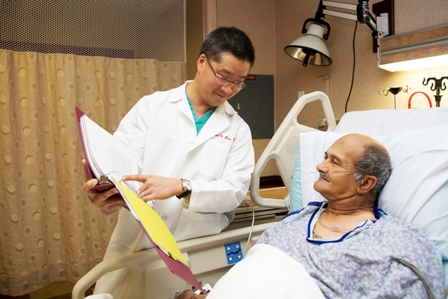New Procedure to Treat Thoracic Aortic Aneurysms Available at NYM
Nov 5, 2008

Leonard Y. Lee, M.D., program director of cardiac surgery, talks with a patient
New York Methodist Hospital's Cornell Heart Center is one of a select group of cardiac surgery programs that now offers a minimally invasive procedure to treat thoracic aortic aneurysms. Thoracic stent grafting, which recently received FDA approval, is designed for the treatment of an aneurysm located in one of the four regions of the aortic arch, a major blood vessel that feeds blood from the heart to the brain.
An aortic aneurysm is characterized by a dangerous swelling of the vessel, which may have been caused by high blood pressure, arteriosclerosis (a hardening of the arteries caused by built-up plaque) or a connective tissue disorder. Untreated, the condition could lead to hemorrhaging and death. While symptoms may include chest pain, back pain, and numbness or tingling of the arms, an aneurysm may cause no symptoms at all and is often identified incidentally, when a patient receives a CT scan or an x-ray to detect another problem.
"This intervention entails a team approach because two areas of specialization-both cardiac surgery and vascular surgery--are required," said Dr. Lee who performs the procedure with Marcus D'Ayala, M.D., NYM's chief of vascular surgery. Thoracic stent grafting has been shown to be very effective in nationwide and international studies. "We have been thrilled with the results", said Leonard Y. Lee, M.D., program director of cardiac surgery at NYM. The company that manufactures the stent graft has named the Hospital a "Center of Expertise for Thoracic Aortic Aneurysm Stent Grafting."
During the procedure, an incision is made near the groin that allows the surgeon to pass the stent graft into the thoracic aorta. Once the stent is in place, a balloon-like device located inside it is expanded. After the stent, which is made of materials that are easily accepted by the body, comes into contact with the aortic wall, the balloon is deflated and withdrawn, leaving the stent in place. Following the procedure, blood travels through the stent and bypasses the aneurysm, creating a new pathway for blood flow. "The aortic walls are no longer under pressure from blood traveling through the aorta," said Dr. Lee.
The procedure takes about one to one and a half hours to perform and recovery time is significantly reduced from traditional surgery, with a hospital stay of approximately two days. "Even though this is a major intervention, recovery time is about the same as for any minor surgical procedure," said Dr. Lee.



